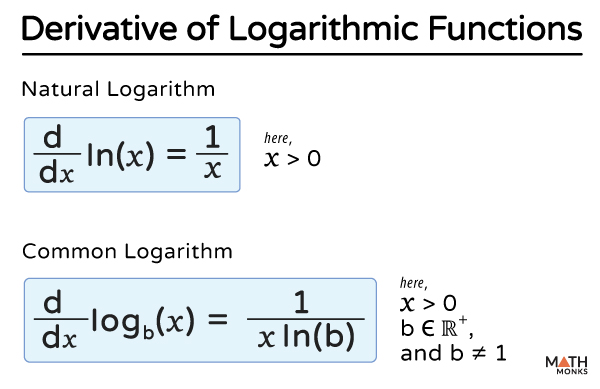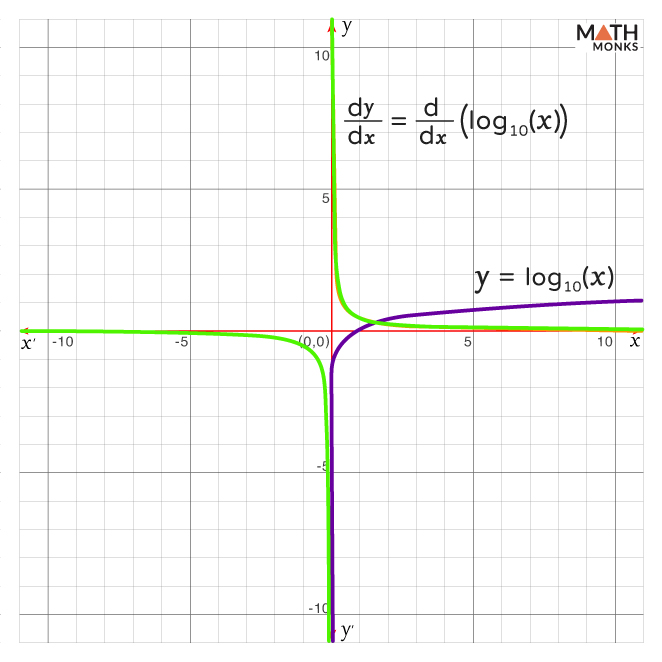Finding the derivative of any logarithmic function is called logarithmic differentiation.
The derivative of the natural logarithmic function (with the base ‘e’), lnx, with respect to ‘x,’ is ${\dfrac{1}{x}}$ and is given by
${\dfrac{d}{dx}\left( \ln x\right) =\left( \ln x\right)’=\dfrac{1}{x}}$, where x > 0
Similarly, the derivative of the logarithmic functions to the base ‘b,’ logbx, with respect to ‘x,’ called the common logarithm ${\dfrac{1}{x\ln b}}$ is represented by
${\dfrac{d}{dx}\left( \log _{b}x\right) =\left( \log _{b}x\right)’=\dfrac{1}{x\ln b}}$, where x > 0 and ‘b’ is any positive real number except 1 (b Є ℝ+ and b ≠ 1)
Proof of the Natural Logarithmic Function
To prove the derivative of the natural logarithmic function, we use the implicit differentiation of its inverse, also known as the exponential form.
Let us assume y = lnx = logex.
Converting it into its exponential form, we get
ey = x
Now, by differentiating both sides with respect to x, we get
${\dfrac{d}{dx}\left( e^{y}\right) =\dfrac{d}{dx}\left( x\right)}$
⇒ ${\dfrac{d}{dx}\left( e^{y}\right) =1}$
⇒ ${e^{y}\ln e\dfrac{dy}{dx}=1}$
Since ey = x, we have
${x\ln e\dfrac{dy}{dx}=1}$
⇒ ${\dfrac{dy}{dx}=\dfrac{1}{x\ln e}}$
Since lne = 1, ${\dfrac{dy}{dx}=\dfrac{1}{x}}$
Mathematically, if h(x) = ln(f(x)), then for all values of x, f(x) > 0, and
${h’\left( x\right) =\dfrac{f’\left( x\right) }{f\left( x\right)}}$
Representing Graphically
The graph of y = logex = lnx and its derivative ${\dfrac{dy}{dx}=\dfrac{1}{x}}$ are shown below.
![]() Differentiate y = ln(2x sinx)
Differentiate y = ln(2x sinx)
Solution:
![]()
As we know, ${\dfrac{d}{dx}\left( \ln x\right) =\dfrac{1}{x}}$
Here, ${y=\ln \left( 2x\sin x\right)}$
⇒ ${\dfrac{dy}{dx}=\dfrac{d}{dx}\left[ \ln \left( 2x\sin x\right) \right]}$
⇒ ${\dfrac{dy}{dx}=\dfrac{1}{2x\sin x}\left( \dfrac{d}{dx}\left( 2x\sin x\right) \right)}$
⇒ ${\dfrac{dy}{dx}=\dfrac{1}{2x\sin x}\left( 2\sin x+2x\cos x\right)}$
⇒ ${\dfrac{dy}{dx}=\dfrac{2\left( \sin x+x\cos x\right) }{2x\sin x}}$
⇒ ${\dfrac{dy}{dx}=\dfrac{\left( \sin x+x\cos x\right) }{x\sin x}}$
Proof of the Common Logarithmic Function
To prove the common logarithmic function’s derivative, we use implicit differentiation similar to that used to prove the natural logarithmic function’s derivative.
Let us assume a logarithmic function y = logbx
Converting it into its exponential form, we get
by = x
Now, by differentiating both sides with respect to x, we get
${\dfrac{d}{dx}\left( b^{y}\right) =\dfrac{d}{dx}\left( x\right)}$
⇒ ${\dfrac{d}{dx}\left( b^{y}\right) =1}$
⇒ ${b^{y}\ln b\dfrac{dy}{dx}=1}$
Since by = x, we have
${x\ln b\dfrac{dy}{dx}=1}$
⇒ ${\dfrac{dy}{dx}=\dfrac{1}{x\ln b}}$
Mathematically, if h(x) = logb(f(x)), then for all values of x, f(x) > 0, and
${h’\left( x\right) =\dfrac{f’\left( x\right) }{f\left( x\right) \ln b}}$
Alternative Method
We can also obtain the derivative formula of the common logarithmic function by using ${\dfrac{d}{dx}\left( \ln x\right) =\dfrac{1}{x}}$
Let us verify this by considering the function f(x) = logbx.
Now, by changing the base rule, we get
${\log _{b}x=\dfrac{\log _{e}x}{\log _{e}b}}$
Since logₑ = ln, f(x) = ${\dfrac{\ln x}{\ln b}}$
Differentiating both sides with respect to x, we get
${f’\left( x\right) =\dfrac{d}{dx}\left( \dfrac{\ln x}{\ln b}\right)}$
⇒ ${f’\left( x\right) =\left( \dfrac{1}{\ln b}\right) \dfrac{d}{dx}\left( \ln x\right)}$
⇒ ${f’\left( x\right) =\left( \dfrac{1}{\ln b}\right) \left( \dfrac{1}{x}\right)}$
⇒ ${\dfrac{d}{dx}\left( \log _{b}x\right) =\dfrac{1}{x\ln b}}$
Thus, the derivative of logbx with respect to x is ${\dfrac{1}{x\ln b}}$, proved.
Representing Graphically
The graph of y = log10x = logx and its derivative ${\dfrac{dy}{dx}=\dfrac{1}{x\ln 10}}$ are shown below.
![]() Differentiate y = log4(5x2 + 7)
Differentiate y = log4(5x2 + 7)
Solution:
![]()
As we know, ${\dfrac{d}{dx}\left( \log _{b}x\right) =\dfrac{1}{x\ln b}}$
Here, ${y=\log _{4}\left( 5x^{2}+7\right)}$
⇒ ${\dfrac{dy}{dx}=\dfrac{d}{dx}\left[ \log _{4}\left( 5x^{2}+7\right) \right]}$
⇒ ${\dfrac{dy}{dx}=\left( \dfrac{1}{5x^{2}+7}\right) \left( \dfrac{1}{\ln 4}\right) \dfrac{d}{dx}\left( 5x^{2}+7\right)}$
⇒ ${\dfrac{dy}{dx}=\left( \dfrac{1}{5x^{2}+7}\right) \left( \dfrac{1}{\ln 2^{2}}\right) \left( 10x\right)}$
⇒ ${\dfrac{dy}{dx}=\left( \dfrac{1}{5x^{2}+7}\right) \left( \dfrac{1}{2\ln 2}\right) \left( 10x\right)}$ (by the power rule of the logarithm)
⇒ ${\dfrac{dy}{dx}=\left( \dfrac{1}{5x^{2}+7}\right) \left( \dfrac{1}{\ln 2}\right) \left( 5x\right)}$
⇒ ${\dfrac{dy}{dx}=\dfrac{5x}{\left( \ln 2\right) \left( 5x^{2}+7\right) }}$



